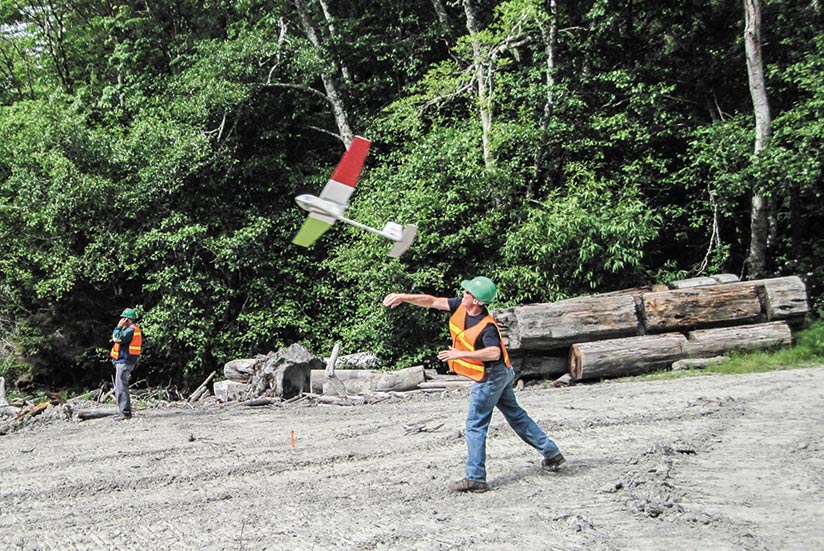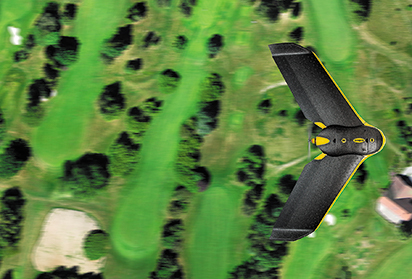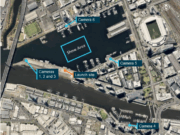
The U.S. Federal Aviation Administration (FAA) is reviewing thousands of opinions and suggestions on the proposed rule1 to regulate small unmanned aircraft systems (sUAS) in the United States (ASW, 4/15, p. 36). At press time, one week before the April 24 deadline, the agency had received 3,459 submissions, with the number sure to increase in the final days of the comment period.
The notice of proposed rule making (NPRM) reminded the aviation industry that to date, “The FAA has accommodated non-recreational small UAS use through various mechanisms, such as special airworthiness certificates, exemptions, and certificates of waiver or authorization [COAs].” (SUAS aircraft are defined as weighing less than 55 lb [25 kg].)
The COA system has enabled public aircraft operators to use unmanned aircraft by obtaining a waiver/deviation from the fundamental see-and-avoid requirement of U.S. Federal Aviation Regulations Part 91.113, the FAA said. That system will remain in place pending introduction of certifiable technological substitutes for pilots’ see-and-avoid capability, and some public aircraft operators will gain COA alternatives when the proposed new Part 107, dedicated to rules for the routine operation of small UAS, takes effect.
“The existing COA system has been in place for over eight years, and has not caused any significant human injuries or other significant adverse safety impacts,” the FAA said. “Accordingly, this proposed rule would not abolish the COA system. However, this proposed rule would provide public aircraft operations with greater flexibility by giving them the option to declare an operation to be a civil operation and comply with the provisions of proposed Part 107 instead of seeking a COA from the FAA. … There would be no adverse safety effects from allowing public aircraft operations to be voluntarily conducted under proposed Part 107.”
The rule making is a breakthrough compared with how the agency granted existing COAs, on a case-by-case basis, to organizations (called sponsors) that are responsible for public aircraft operations by custom-tailoring risk mitigations to keep UAS separate from manned-aircraft operations. Recently released FAA documents provide insights into factors that have influenced the agency’s perspectives. They describe, for example, how the individual sponsors have met COA-qualification requirements, their compliance and COA extensions over time, and safety-outcome data (see Table 1 and “FAA Database Tallies UAS Experience, 2009–2014”). COAs, accident/incident reports from operators and reports submitted by UAS crewmembers under voluntary reporting systems show the ties to the risk factors discussed in the NPRM.2
| Date | Location | Aircraft Type | Aircraft Damage |
|---|---|---|---|
Notes
Source: U.S. Federal Aviation Administration via MuckRock News |
|||
| 4/18/12 | Northwest side of Socorro Peak, New Mexico | Cutlass | Destroyed |
| “While the New Mexico Institute of Mining and Technology [unmanned aircraft system (UAS) aircraft] was on the way back [from an explosives research range], the PIC [pilot-in-command] got a bad GPS [global positioning system] data report on the GCS [ground control station display]. The PIC attempted to recover the UA … while in RDR [remote directional response] flight mode. The PIC was unable to recover the UA. … At that point, with the MC [mission control] approval, the PIC terminated the flight into the mountain while the UA was still flying in a stable attitude although — because of the IMU [inertial measurement unit] processing — it was degrading rapidly. This was decided so that a [fly-away] could be prevented.” | |||
| 6/19/12 | About 5 mi (8 km) southwest of Port Angeles, Washington | Raven A | Crash (not specified) |
| “The Department of Interior aircraft was commanded to return to its ‘home’ waypoint in order to avoid flying in the same vicinity as a manned Piper J3 Cub. En route to its ‘home’ waypoint, the UAS operator determined it was necessary to decrease the Raven’s altitude in order to avoid the J3 Cub that continued to maneuver in the Raven’s proposed flight path despite UAS operations being announced over VHF [very high frequency radio] 122.975 MHz and [a] NOTAM [notice to airmen] being in place. The Raven impacted trees en route to its ‘home’ waypoint.” | |||
| 8/22/12 | Lake Conroe Dam UAS Site, Texas | ShadowHawk | Crash (not specified) |
| “The accident was due to a failure to follow the checklist by the Montgomery County Sheriff’s Office tactical flight crew. A step — GPS [global positioning system receiver] internal/external [selection] — was not validated properly [so] the GPS was in the internal mode and should have been set to external mode. This failure to confirm external mode resulted in poor GPS signal [reception by] the aircraft. This prevented the aircraft from more accurately determining position, which resulted in an erratic launch. … The PIC activated the abort function, which caused the aircraft to come down 50 yd [46 m] from the landing pad in a non-level attitude due to the poor GPS signal.” | |||
| 10/3/12 | Grass near UAS runway within COA boundary, Kansas | Penguin B | Hard landing (not specified) |
| “A GCS software malfunction caused Kansas State University’s UA to switch its altitude from 500 ft AGL [above ground level] to [500 ft] MSL [above mean sea level] and to begin a descent. The VO [visual observer] did not communicate the UA’s altitude [to the PIC] until 150 ft AGL, which was too late for the PIC to input a command to ascend, resulting in a hard landing. The non-commanded descent of the aircraft was caused by the operator software failing to correct target AGL altitude to MSL when the aircraft’s altitude-control loop was switched on.” | |||
| 8/16/13 | Smithfield, Virginia | Ultra Stik 120 AirStar | Crash (not specified) |
| “NASA–Langley Research Center’s RC [radio-controlled] model sUAS [small UAS] crashed while landing during pilot training. The pilot was in the process of completing the second of three training events for recurrency when, on final approach, the vehicle began to drift off the runway centerline at an altitude of approximately 50 ft AGL. The observer directed the pilot to make corrections with directional control (rudder) to re-establish runway centerline positioning for landing when the pilot became disoriented [by] the control response. The vehicle continued to lose airspeed, rolled to the right and crashed in the no-fly pit area.” | |||
| 11/5/13 | Moyock, North Carolina | Vireo | Crash (not specified) |
| “North Carolina State University’s aircraft was successfully launched into the wind … and climbed to an altitude of 90 ft AGL. Based upon the telemetry at seven to eight seconds into the flight, the aircraft lost 17 kt of airspeed in 1 second, stalled [and] lost 45 ft of altitude. Concurrently, the heading of the aircraft changed 80 degrees to the right. The aircraft recovered from the stall and began to climb, but struck [a] vacant hangar at approximately 35 ft AGL, 10 to 12 seconds after launch.” | |||
| 11/18/13 | San Miguel Island, California | Puma AE | Destroyed |
| “The National Oceanic and Atmospheric Administration’s (NOAA’s) Puma was conducting science-survey operations near San Miguel Island at 400 ft. It was operated from the deck of the NOAA ship Shearwater. The Puma started to outrun the vessel, and navigation was switched to an orbit point to keep the Puma within 1.0 mi (1.6 km) of the GCS and allow the vessel to catch back up to the Puma. A short time later, the Puma impacted the terrain of San Miguel Island. A recovery team located all parts of the Puma.” | |||
| 4/12/14 | Lake Arlington Dam, Texas | Leptron Avenger | Destroyed |
| “The Arlington Police Department’s PIC and sensor operator were practicing camera operations. The sensor operator asked [the PIC] to descend 25 ft (to approximately 75 ft AGL). After descent, the UAS [aircraft] failed to respond and began slipping backwards (tail first). The [rate] of acceleration was dramatic, and the aircraft did not respond to immediate input of the ‘lost link’ procedure. The aircraft went faster than its programmed speed ‘governor,’ and ultimately impacted a dirt berm inside the training and evaluation site. The [aircraft] disintegrated upon impact.” | |||
Insights From COAs
The sources generally indicate that typical COA sponsors operating small UAS, with perhaps few exceptions, already apply risk mitigations that match those in the NPRM, such as direct line-of-sight of the aircraft, visual observers, pre-flight airworthiness checks, pre-flight checks of data/communication links, vertical boundaries to the area of operation, pre-flight environment assessment, protecting people positioned below the flight path, and reporting specified accidents, incidents and flight anomalies. One correlation between COA-sponsor experiences and the NPRM is a situation described by a number of the sources reviewed. The issue is operator readiness to take action — and to destroy an unmanned aircraft when necessary — to eliminate impending risk of collision with a manned aircraft.
The FAA describes the situation as follows: “Because of these challenges, the FAA proposes to require … that the small UAS operator must always be the one to initiate an avoidance maneuver to avoid collision with any other user of the NAS [National Airspace System]. Optimally, the small UAS operator should give right-of-way to all manned aircraft in such a manner that the manned aircraft is never presented with a see-and-avoid decision or the impression that it must maneuver to avoid the small UAS. When a small UAS operator encounters another unmanned aircraft, each operator must exercise his or her discretion to avoid a collision between the aircraft. In extreme situations where collision is imminent, the small UAS operator must always consider the safety of people, first and foremost, over the value of any equipment, even if it means the loss of the unmanned aircraft.” No system for automatic termination of the flight of a fly-away UAS aircraft has been proposed, the FAA said.
 Another correlation between COA-sponsor experiences and the NPRM appeared in a number of documents. These are operator/pilot preparations for loss of positive control of a UAS aircraft and how they manage lost-link/lost-communication instances during flights. “One of the issues unique to UAS operations is the possibility that during flight, the UAS operator may become unable to directly control the unmanned aircraft due to a failure of the control link between the aircraft and the operator’s [ground] control station,” the FAA said. “To address this issue, the FAA proposes a performance-based operator-responsibility standard built around the concept of a confined area of operation. Confining the flight of a small unmanned aircraft to a limited area would allow the operator to become familiar with the area of operation and to create contingency plans for using the environment in that area.”
Another correlation between COA-sponsor experiences and the NPRM appeared in a number of documents. These are operator/pilot preparations for loss of positive control of a UAS aircraft and how they manage lost-link/lost-communication instances during flights. “One of the issues unique to UAS operations is the possibility that during flight, the UAS operator may become unable to directly control the unmanned aircraft due to a failure of the control link between the aircraft and the operator’s [ground] control station,” the FAA said. “To address this issue, the FAA proposes a performance-based operator-responsibility standard built around the concept of a confined area of operation. Confining the flight of a small unmanned aircraft to a limited area would allow the operator to become familiar with the area of operation and to create contingency plans for using the environment in that area.”
The NPRM emphasizes, “The first safety concern is whether the person operating the small unmanned aircraft, who would be physically separated from that aircraft during flight, would have the ability to see manned aircraft in the air in time to prevent a midair collision between the small unmanned aircraft and another aircraft. …
“The second safety concern with small UAS operations is the possibility that, during flight, the person operating the small UAS may become unable to use the control interface to operate the small unmanned aircraft due to a failure of the control link between the aircraft and the operator’s [ground] control station. This is known as a loss of positive control. This situation may result from a system failure or because the aircraft has been flown beyond the signal range or in an area where control link communication between the aircraft and the control station is interrupted. A small unmanned aircraft whose flight is unable to be directly controlled could pose a significant risk to persons, property, or other aircraft.”
COA Principles in Action
Among 104 incidents and accidents that UAS sponsors reported to the FAA in 2010–2014, the following incidents were helpful in visualizing the nature of real-world UAS technical challenges and pilot decision making in light of priorities covered in the NPRM.
On March 19, 2012, Middle Tennessee State University’s Prioria Maveric was landed safely after the flight crew experienced multiple instances of lost-link/lost-communication in one day at the designated UAS site’s geospatial coordinates in Tennessee. After three successful sorties, the crew identified the first loss of communication between the aircraft and the ground control station.
The report said, “The aircraft entered its lost-link procedure after the 10-second time elapsed. The aircraft flew the lost-link procedure and performed an autonomous landing at the landing site with no damage to the aircraft. [Troubleshooting failed to] determine the cause [and] the failure could not be duplicated. The crew then performed a one-hour ground test of the system to ensure link stability and had zero discrepancies with the communications. [During] the sixth sortie … the system experienced another loss of communications. Communications with the aircraft were restored [in flight] … and the aircraft was brought back for landing. … The aircraft [then] experienced another loss of communications and re-entered the lost-link procedure. Control of the aircraft was regained … and the aircraft was maneuvered for landing. The link failed a third time … on final approach and [the aircraft] once again entered lost-link procedures. Link was regained, and the aircraft was successfully landed in manual mode. …
“The aircraft remained inside the COA [operational area], the assigned ROZ [restricted operating zone] and within visual line-of-sight at all times. No persons or property were threatened at any time. Flight operations were canceled until the issue with the system could be resolved and the FAA notified.”
On July 6, 2011, the Miami-Dade Police Department lost navigational control of its Micro Air Vehicle (MAV) T-Hawk during the 12th training flight of the day at a test area in the Everglades swamp, Florida. To keep the aircraft within that area, the pilot responded by successfully commanding it to shut down engine power.
The sponsor’s report to the FAA said, “[The aircraft] experienced a loss of GPS [global positioning system] signal. The MAV had been airborne for approximately four minutes when … the pilot was alerted to ‘AV [air vehicle] degraded navigation.’ This resulted in the loss of the primary system that the MAV utilizes for navigation, and it was only able to maintain itself upright. The MAV was in the process of landing when this event took place, and the aircraft began slowly drifting with the winds away from the landing area. The MAV was heading toward rising terrain with numerous trees. Fearing that the MAV would strike a tree or — if it made it past the trees — would continue outside of the test area, the pilot followed [COA] procedures and an ‘engine kill’ command was issued to the MAV … as it flew over an area overgrown with numerous tall shrubs and grass, which hopefully would cushion the landing.”
Notes
- U.S. Department of Transportation, FAA. “Operation and Certification of Small Unmanned Aircraft Systems; Proposed Rule.” Federal Register, Volume 80 Number 35, Part III, Feb. 23, 2015. <www.regulations.gov/#!documentDetail;D=FAA-2015-0150-0017>.
- The COA information reviewed for this article came from the FAA website in the context of legal action brought by the Electronic Frontier Foundation.


